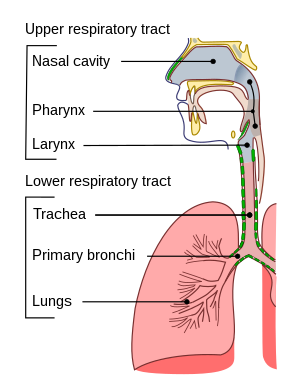Pulmonary aspiration
| Pulmonary aspiration | |
|---|---|
 |
|
| Upper respiratory tract (pharynx and larynx) and lower respiratory tract (trachea, bronchi, and lung) | |
| Classification and external resources | |
| Specialty | Pulmonology |
| ICD-10 |
J69, J95.4 |
| ICD-9-CM | 668.0, 997.3 |
| DiseasesDB | 979 |
| MeSH | D053120 |
J69, J95.4
O29.0, O74.0
O89.0, P24
T17.3–T17.9
Pulmonary aspiration is the entry of material (such as pharyngeal secretions, food or drink, or stomach contents) from the oropharynx or gastrointestinal tract into the larynx (voice box) and lower respiratory tract (the portions of the respiratory system from the trachea—i.e., windpipe—to the lungs). A person may either inhale the material, or it may be delivered into the tracheobronchial tree during positive pressure ventilation. When pulmonary aspiration occurs during eating and drinking, the aspirated material is often colloquially referred to as "going down the wrong pipe."
Consequences of pulmonary aspiration range from no injury at all, to chemical pneumonitis or pneumonia, to death within minutes from asphyxiation. These consequences depend in part on the volume, chemical composition, particle size, presence or absence of infectious agents, and underlying health status of the person. In healthy people, aspiration of small quantities of material is common and rarely results in disease or injury. People with significant underlying disease or injury, especially hospitalized patients, are at greater risk for developing respiratory complications following pulmonary aspiration because of certain factors such as depressed level of consciousness and impaired airway defenses (gag reflex and/or respiratory tract antimicrobial defense system). As the lumen of the right main bronchus is more vertical and of slightly wider diameter than that of the left, aspirated material is more likely to end up in this bronchus or one of its subsequent .
...
Wikipedia
